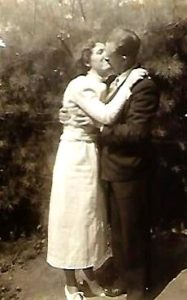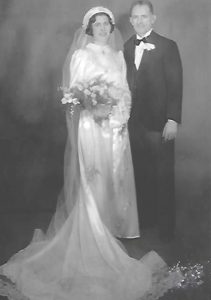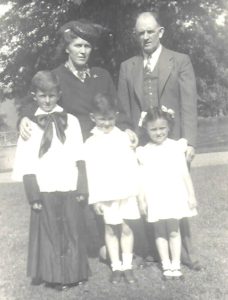The current interest in ancestry is all the rage–people looking for their roots. I was blessed to have grown up with all four grandparents, several aunts and uncles and many, many cousins all living in close proximity. My BelovED was not so fortunate, but there were threads we were able to trace to get to know his parents.
Edmond O’Connell was born in Newcastle, the largest town in County Limerick, Ireland, (excluding Limerick City) at the dawn of the twentieth century. It was a country very much part of the British Empire, but cultural nationalism was gaining impetus. Old Irish customs were preserved, and the previously suppressed spoken language was revived. Irish nationalism ultimately led to most of the island seceding from the UK in 1921, but with independence came the plague of poverty and emigration.
Faced with the choice of remaining in Ireland or seeking new opportunities elsewhere, Edmond decided to take on the challenge and came to America to make his new life. He was the only one of his family to make the journey.
Julia Agnes Long was born in 1907 literally in the Fields of Athenry, on a farm in County Galway. She was a spirited young woman who sought more than what the agrarian life could offer. She emigrated to America with her older brother, Michael, and came to Boston where some cousins had previously settled, then traveled to New York City to seek employment.
 The two lived just 104.7 km (approx 65 miles) apart, a distance that could be traversed in a little over an hour on highway M18, but traveled over three thousand miles across the ocean and took several years to find each other. There are no details of how and when the two young immigrants met, but it was probably through the Irish-American cultural societies that provided the social network opportunities of the time.
The two lived just 104.7 km (approx 65 miles) apart, a distance that could be traversed in a little over an hour on highway M18, but traveled over three thousand miles across the ocean and took several years to find each other. There are no details of how and when the two young immigrants met, but it was probably through the Irish-American cultural societies that provided the social network opportunities of the time.
Like many of the young Irishmen, Edmond worked for the New York Subway System. They were poor, overworked victims of the 84-hour work week, so low down on the economic and social ladder they had nowhere to go but up. Inspired by the labor leaders and revolutionaries of the time, the transit workers organized, and in 1934 Michael Quill founded the Transit Workers Union, winning a six-day work week and the benefits of fraternity.
 Intelligent, refined and stylish, Julia was employed as a housemaid for a wealthy family on Park Avenue. She enjoyed the ambiance of a privileged lifestyle, if not its benefits. She became an American citizen in May of 1930; Edmond obtained his citizenship in December of 1935. They applied for their marriage license in February, 1937, were married on April third, and set up housekeeping in a small apartment on Post Avenue in the Inwood section of Manhattan. Their first child, a son (Edward), was born on the last day of the same year. A second son (Denis) followed two and a half years later. They bought a car and a sturdy brick row house in the Bronx and moved their growing family just in time for the arrival of a daughter (Mary) in January, 1942.
Intelligent, refined and stylish, Julia was employed as a housemaid for a wealthy family on Park Avenue. She enjoyed the ambiance of a privileged lifestyle, if not its benefits. She became an American citizen in May of 1930; Edmond obtained his citizenship in December of 1935. They applied for their marriage license in February, 1937, were married on April third, and set up housekeeping in a small apartment on Post Avenue in the Inwood section of Manhattan. Their first child, a son (Edward), was born on the last day of the same year. A second son (Denis) followed two and a half years later. They bought a car and a sturdy brick row house in the Bronx and moved their growing family just in time for the arrival of a daughter (Mary) in January, 1942.
Living their American dream, they were active participants in Holy Rosary parish where the children could attend the parochial school when they came of age. They took Sunday drives to the country and the beach and to visit family and friends in New Jersey. The children had toys, bicycles, and playmates; and there was even a model train set in the basement.
 Their idyllic life was interrupted in 1945 when Julia became ill with a respiratory illness, probably TB, and was sent to a sanitarium to recover and recuperate. Unable to care for his children while working, Edmond sent his sons to St. Dominic’s Home in Blauvelt, NY, where Sister Sabina Burke, a cousin, was on the staff; and Mary was sent to be cared for by Uncle Michael and Aunt May who lived in Bayonne.
Their idyllic life was interrupted in 1945 when Julia became ill with a respiratory illness, probably TB, and was sent to a sanitarium to recover and recuperate. Unable to care for his children while working, Edmond sent his sons to St. Dominic’s Home in Blauvelt, NY, where Sister Sabina Burke, a cousin, was on the staff; and Mary was sent to be cared for by Uncle Michael and Aunt May who lived in Bayonne.
Julia was well enough to return home in time for Christmas, 1947, and was looking forward to reuniting her family and celebrating the holiday and her children’s birthdays. Mary, now five, came home first, and she and her mother went into Manhattan to buy a special doll at FAO Schwartz and to shop for gifts for the boys.
While they were out Edmond finished cleaning up after the painting he had done in preparation for his wife’s homecoming. He threw some rags into the coal- burning furnace and his clothing ignited. He ran outside and rolled in the snow to squelch the flames. A neighbor who was shoveling his walk witnessed the scene and called for an ambulance. When Julia and Mary returned from shopping, they learned that he was in serious condition at the hospital. Edmond died from his injuries on December 31st, his son’s tenth birthday, and his funeral Mass was on January 3rd, his daughter’s sixth birthday. Because of a blizzard, the boys could not get back home and in fact stayed on at St. Dominic’s for another year.
With the help of family and friends, Julia tried as best she could to keep going. She took in a boarder to earn some extra income. The boys returned home to the Bronx after the school year in 1949, and Eddie had a paper route and a job after school and on weekends at the neighborhood soda shop. But her frail health, grief and stress took its toll and she developed a bleeding ulcer and was admitted to Fordham Hospital where she died in February, 1954.
Her brother Michael and his wife May, who had four teenage sons of their own, took in the three orphans and treated them as their own. With an abundance of faith and love, there was always enough of whatever they needed.
Edmond and Julia are buried in St. Raymond’s cemetery in the Bronx. One day several years ago, returning from a family wedding in Nantucket, we stopped by to visit the grave. It was a beautiful mid-October day. The trees were arrayed at the height of their color, the sun was shining and the sky was a bright azure blue, cloudless except for a puff about the size of a Goodyear blimp overhead. Both Ed and I noticed and commented on the unusual sight..
We found the stone engraved with their names, and holding hands prayed together both for the repose of their souls and in thanksgiving for the many years of marriage with which we had been blessed. I asked My belovED if he thought his parents would have approved of me as a daughter-in-law. Without hesitation he answered in the affirmative. As we stood there it began to snow. Fine feathery flakes followed us to the car; and as we drove away, we noticed the little white cloud was gone.
Wonderful story
Enjoy reading your blogs.
How sad that we are not all blessed with long lives together. I had only five years with my beloved George, who was my hero, but I know that I will see him again in the next life.